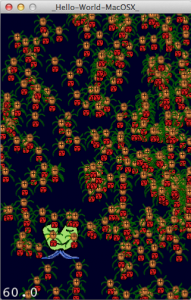Cocos2D is a rendering engine. Note the emphasis. 90% of what it does is draw stuff onto the screen and animate it. It adds some input processing and scheduling and the rest is up to you.
A game engine is to cocos2d what cocos2d is to OpenGL. The list of things I want in an actual game engine is long.
The iOS mobile platform has advanced far enough that a pure rendering engine just isn’t that much of a help anymore. We’re effectively moving back towards where we were back in 2008 if we don’t start pushing the boundaries, hard.
Here are some ideas I have for and would like to see in a 2D game engine, in no particular order. It is not a feature list for Kobold Kit, but it does reflect what I want to make possible with / encourage for Kobold Kit. Continue reading »
 Here’s a crazy thought: with commercial game kits (game source code products) being popular and financially rewarding – why not crowd-fund an iOS game by selling it’s source code, resources and development insights while you’re creating it?
Here’s a crazy thought: with commercial game kits (game source code products) being popular and financially rewarding – why not crowd-fund an iOS game by selling it’s source code, resources and development insights while you’re creating it?
Marcus and I will give this idea a spin. Marcus is a game designer I worked with at Electronic Arts Phenomic for 6 years. I’m sure you know me. Together we’re going to create a tilemap-based physics game using cocos2d and KoboldScript (Lua scripting for cocos2d). And we are going to sell everything we’ll create practically from day one.
If that sounds even slightly intruiging to you, we’d love to get your feedback!
Visit the launch page and take our survey which has already helped us tremendously to focus on what’s important for you. For example I’ve converted the entire KoboldScript library to use ARC seeing how important ARC is to you.
But do keep on reading for more details … Continue reading »
 In this episode of LearnCocosTV I demonstrate how to write and animate a Cocos2D scene with KoboldScript.
In this episode of LearnCocosTV I demonstrate how to write and animate a Cocos2D scene with KoboldScript.
KoboldScript is more than just writing the same Cocos2D code but with a scripting language. Most other scripting language bindings for game engines simply translate the game engine’s C/C++/Objective-C API 1:1 (more or less) without introducing new concepts, adding more comfort by simplifying common tasks, or utilizing the powerful features of whatever the scripting language has to offer.
KoboldScript goes three steps further than that - one by tightly integrating the setup of scenes via defining the node properties in a tool-friendly tree structure (Lua table) that you can both write manually or create programmatically using Lua’s built-in features.
Two, by using Statemachines to drive game logic while also providing free Lua scripting via user-specified Lua callback functions. And three, by adding a (MVC-ish) component system with re-usable abilities and behaviors to all Cocos2D nodes.
Unfortunately I ran out of time at the end so I couldn’t even say goodbye. I hope you don’t mind. 
Episode #6 - One Small Script for Man …
• KoboldScript Demonstration
o How to create Scenes with Sprites, etc
o How Abilities & Behaviors work
• iDevBlogADay: Asynchronous Texture Loading
o Cocos2D Webcam Viewer speedup
KoboldScript is coming! KoboldScript brings Lua scripting to Cocos2D and Kobold2D, with Objective-C performance for the StateMachine part and faster-than-Wax performance for the runtime Lua functions.
More details and first looks at some early development scripts in this LearnCocosTV episode. I’ll have something more visual to show in 2-4 weeks.
Episode #5 - Pretty State Machine
• KoboldScript: Lua Scripting for Cocos2D & Kobold2D Continue reading »
o Poll: Which scripting language for Cocos2D?
o iDevBlogADay: Text Editors for Lua
• KoboldScript combines:
o Lua StateMachine generator (full ObjC performance)
o Runtime Lua functions (faster than Wax)










